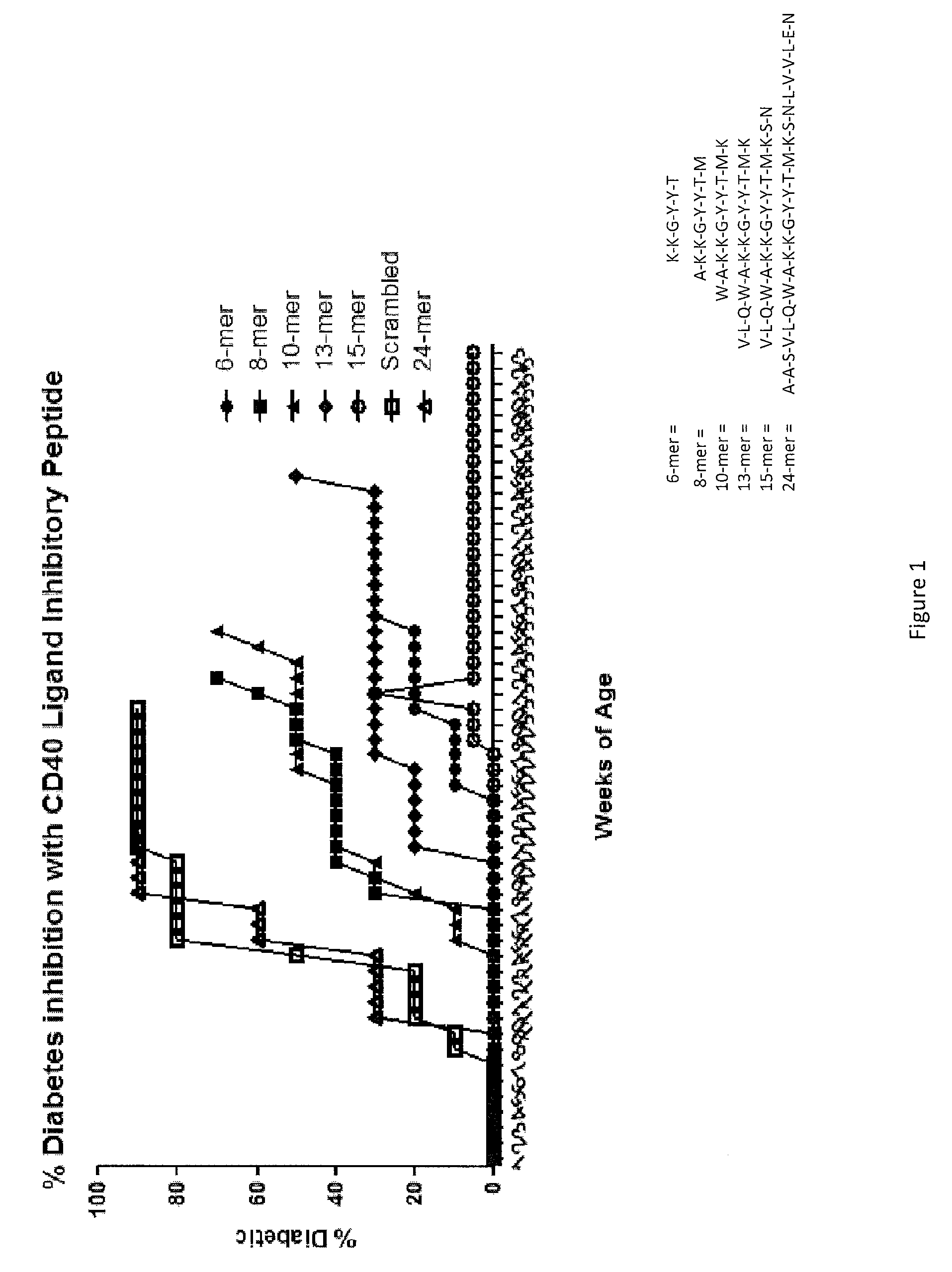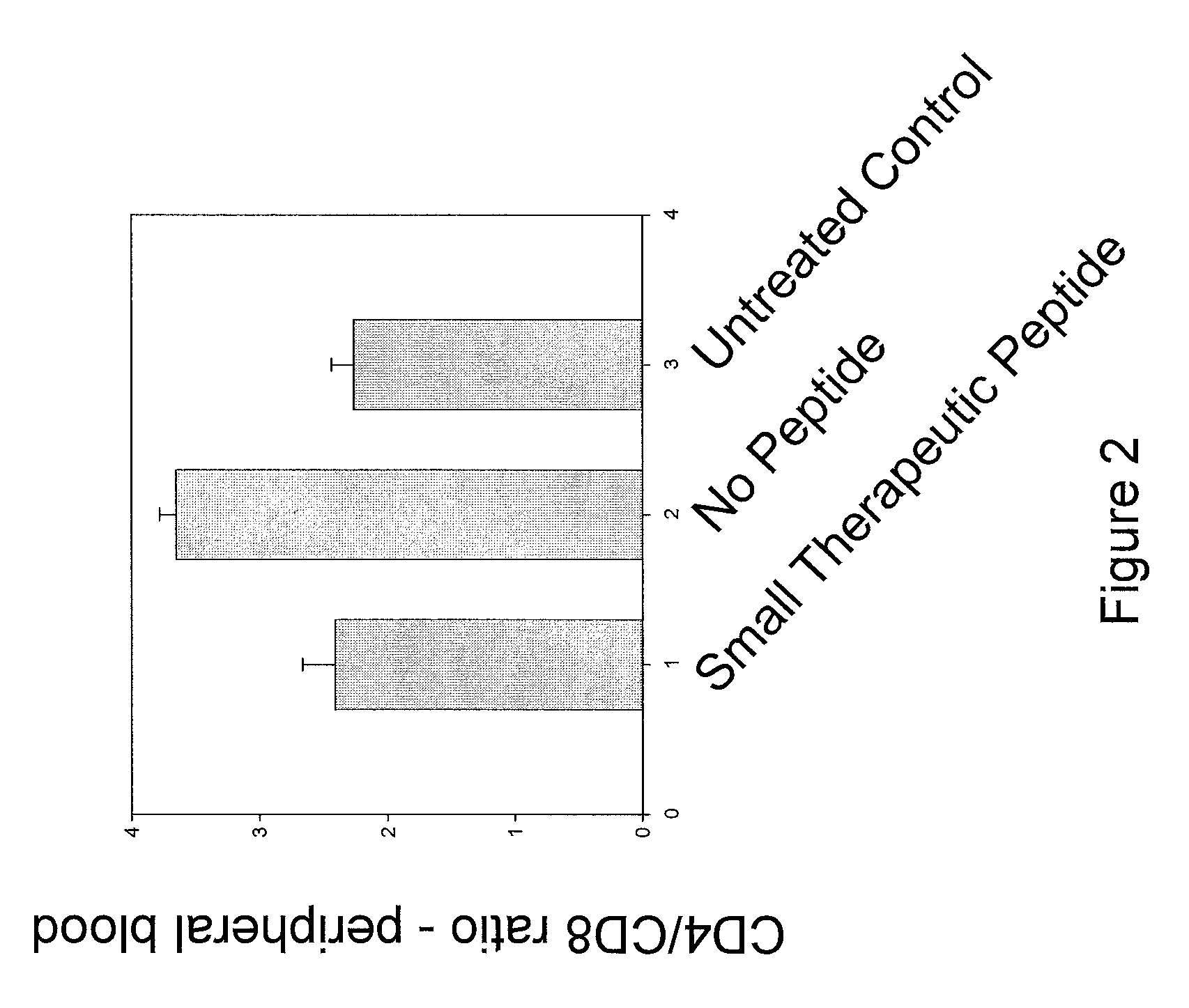Pegylated CD154 peptides and methods of inhibiting CD40 interacations with CD154
a technology of cd154 and peptides, which is applied in the field of peptides, can solve the problems of aseptic chronic inflammation, tissue degeneration, and life-altering and in some cases life-threatening, and achieve the effect of reducing the level of th40 cells and reducing the severity of diseas
- Summary
- Abstract
- Description
- Claims
- Application Information
AI Technical Summary
Benefits of technology
Problems solved by technology
Method used
Image
Examples
example 1
[0063]This Example demonstrates the effect of various peptide fragments of CD154 on CD4 / CD8 ratios and the development of diabetes in NOD mice.
[0064]Peptides were designed based on the amino acid sequence of mouse CD154 protein (SEQ ID NO:1) in the SwissPro database. The peptides were then ordered from New England Peptide. The lyophilized peptides were suspended in sterile saline at 1 mg / ml. 100 ug of a particular peptide was then injected into the tail vein of 8-9 week old NOD mice. Control mice received 100 ul of sterile saline. This is well before the onset of diabetes, but after damage to pancreatic islets has begun. Three days after the initial injection, another 100 ug of peptide (or 100 ul of saline in the case of the Control mice) was injected into the tail vein. Mice were then injected with peptide (or saline) on a weekly basis. At 10 weeks of age, mice were monitored for diabetes, as indicated by a blood glucose level greater than 250 mg / dL for three consecutive days. The ...
example 2
[0066]This Example demonstrates the effect of the 15-mer peptide on hyperglycemia in newly diabetic NOD mice.
[0067]Six mice from that had received the 6-mer peptide in Example 1, and that had subsequently developed diabetes, were injected intravenously with 100 ug of the 15-mer peptide. These mice were then given weekly injections of the 15-mer peptide into their tail veins, and their blood glucose levels monitored twice-weekly. The 15-mer peptide was administered for a total of ten weeks, after which the treatment was stopped. The results of this study are shown in FIG. 3.
[0068]This study demonstrates that injection of the 15-mer peptide into already diabetic mice can reverse hyperglycemia. It also demonstrates that cessation of the treatment results in return of hyperglycemia within 7 weeks.
example 3
[0069]This study demonstrates the ability of the 15-mer peptide to bind to Th40 cell and B cells.
[0070]Total lymphocytes were isolated from 9 week old NOD mice. The lymphocytes were incubated with anti-CD, anti-CD8, and an FITC-labeled 15-mer peptide, and then analyzed by flow cytometry. Cells were gated for CD4 (both CD4hi and CD4lo populations were included) and CD4 versus the 15-mer peptide. The results of this analysis are shown in FIG. 4.
[0071]B cells were isolated from the spleens of NOD mice. Sorted MHC-II+ cells were purified from total lymphocytes. Cells were stained with FITC-labeled 15 mer peptide, anti-CD40, and B cell markers CD19 and CD21. MHC-II+ cells were gated for CD19+ and CD21+ and then 15-mer peptide versus Cd40 antibody was measured. The results of this study are shown in FIG. 5.
[0072]This study shows that a substantial majority, 90% of CD40+ T-cells, also bind the 15-mer peptide, thereby demonstrating that the 15-mer peptide is highly specific for CD40+ cells....
PUM
| Property | Measurement | Unit |
|---|---|---|
| size | aaaaa | aaaaa |
| length | aaaaa | aaaaa |
| non-covalent binding interactions | aaaaa | aaaaa |
Abstract
Description
Claims
Application Information
 Login to View More
Login to View More - R&D
- Intellectual Property
- Life Sciences
- Materials
- Tech Scout
- Unparalleled Data Quality
- Higher Quality Content
- 60% Fewer Hallucinations
Browse by: Latest US Patents, China's latest patents, Technical Efficacy Thesaurus, Application Domain, Technology Topic, Popular Technical Reports.
© 2025 PatSnap. All rights reserved.Legal|Privacy policy|Modern Slavery Act Transparency Statement|Sitemap|About US| Contact US: help@patsnap.com



